Disclosure: Meeple Mountain received a free copy of this product in exchange for an honest, unbiased review. This review is not intended to be an endorsement.
“Hog Butcher for the World,
Tool Maker, Stacker of Wheat,
Player with Railroads and the Nation’s Freight Handler;
Stormy, husky, brawling,
City of the Big Shoulders”
Thus begins Carl Sandburg’s famous 1914 poem “Chicago”. It’s more than just a poem; it’s a love letter written to the city that he held dear. City of the Big Shoulders, designed by Raymond Chandler III, is like that poem. It’s a love letter in the form of a board game.
Overview
City of the Big Shoulders is an 18xx style game. 18xx games take place during the 19th century and typically revolve around the creation of and investing in railroads. One of the most profitable locations in many 18xx games is the city of Chicago, Illinois. City of the Big Shoulders moves away from trains to delve into what it was about Chicago during that time period that made it such a powerhouse.
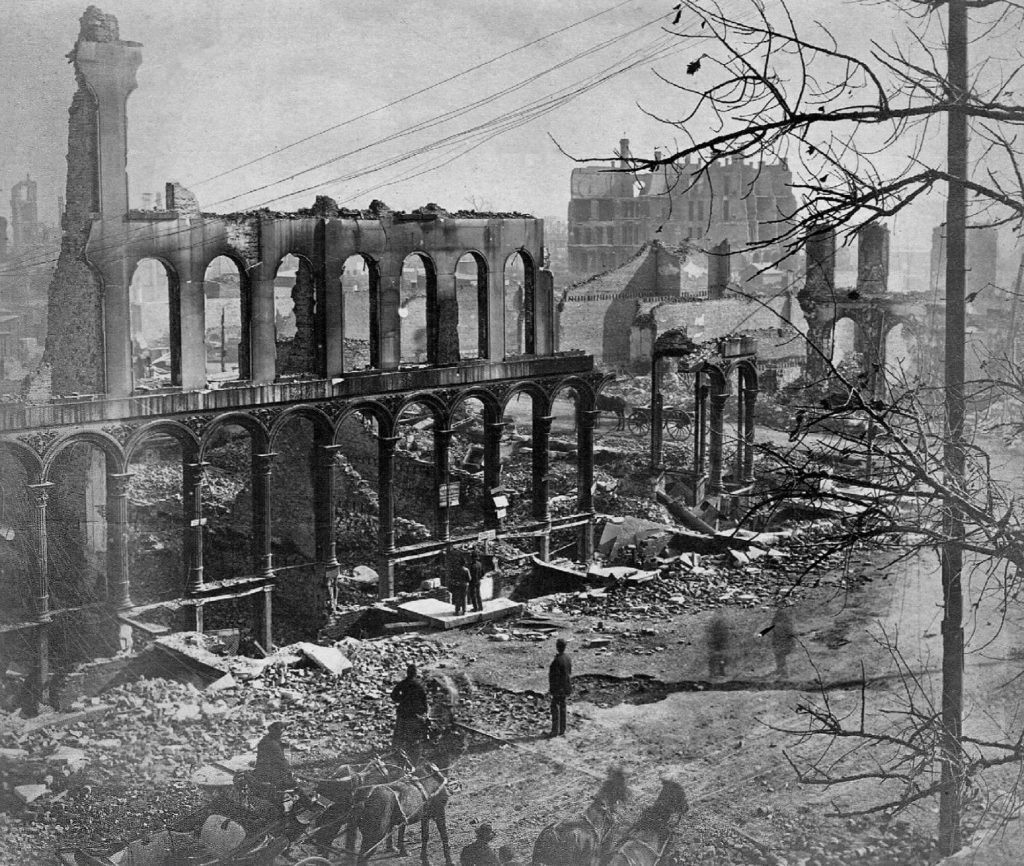
Taking place in the years immediately following the Great Chicago Fire of 1871, City of the Big Shoulders sees the players taking on the roles of savvy investors working to rebuild the city by creating and investing in local businesses. After starting up a business, players need to hire workers in order to produce goods to be sold, earning money which will be reinvested in more businesses, used to hire more workers, and to produce more products. These investments come in the form of company stocks. As the companies grow, they may pay out dividends to their shareholders, and this money matters. In the end that’s what it’s all about… making bank.
Now if you’re only interested in finding out what I think about City of the Big Shoulders, feel free to scroll down to the Thoughts section. If you’re interested in getting a feel for how the game is played, then read on. Note: this game is a beast and there is a lot going on, so I’m going to try to keep it brief and just give you a high level overview.
Setup
Because this is such a complex game with so many components and because I am trying to keep it brief, there is going to be some terminology thrown out there during the setup overview that won’t make immediate sense. I will come back around to these terms later to give them some context.
First, the game board is setup and the various game board sections are populated. Sort and place the Demand tiles, then the Capital Asset tiles. Sort the building tiles by era and place them onto the board. Fill the shaded areas of the Job Market with workers. Finally, prepare a bank of money.
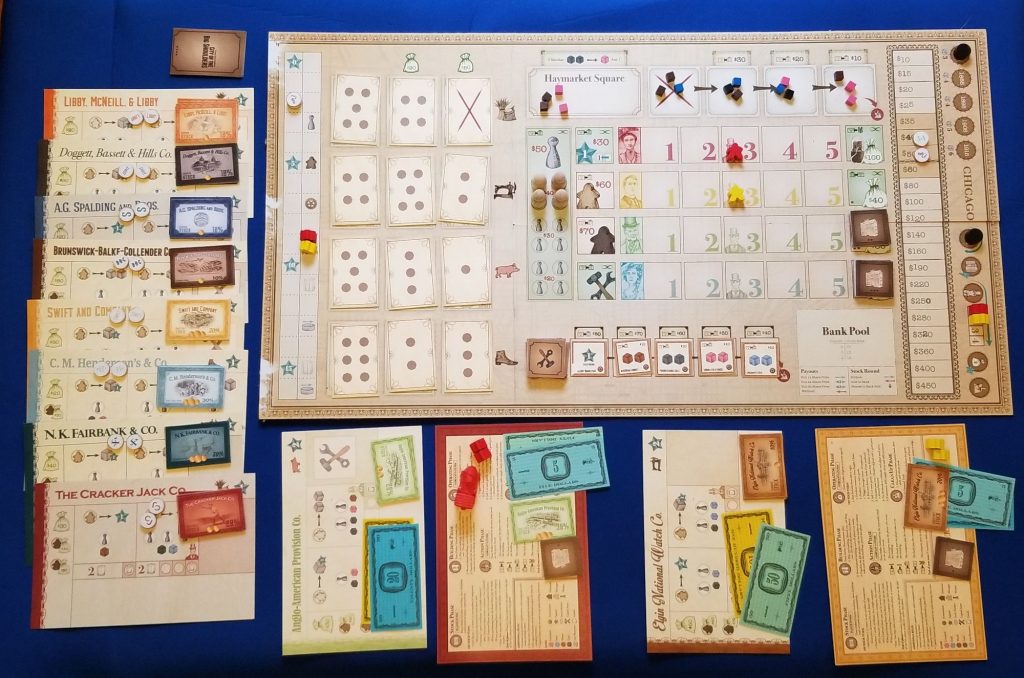
Next, place two of each of the resource cubes onto Haymarket Square and place the rest in the bag. After giving the bag a good shake, draw three resources for each space of the supply chain along the top of the board. Set the Decade and Phase markers to their starting positions. All other bits and pieces are set off to the side for now.
Finally, each player chooses a color and takes the corresponding player board and pieces. Everyone receives $175 and three buildings from the era 1 Building tile deck. Then you’re ready to begin playing!
The First Order of Business Is To Actually Start One
After randomly choosing a start player, players take turns, in player order, selecting their starting companies. When starting a company (and this is true for starting a company at any time during the course of the game) you MUST purchase the Director’s Certificate (awarding 30% ownership of the company). The cost for this purchase hinges on the company’s starting Share Value (determined by you); either $35, $40, $50, or $60.
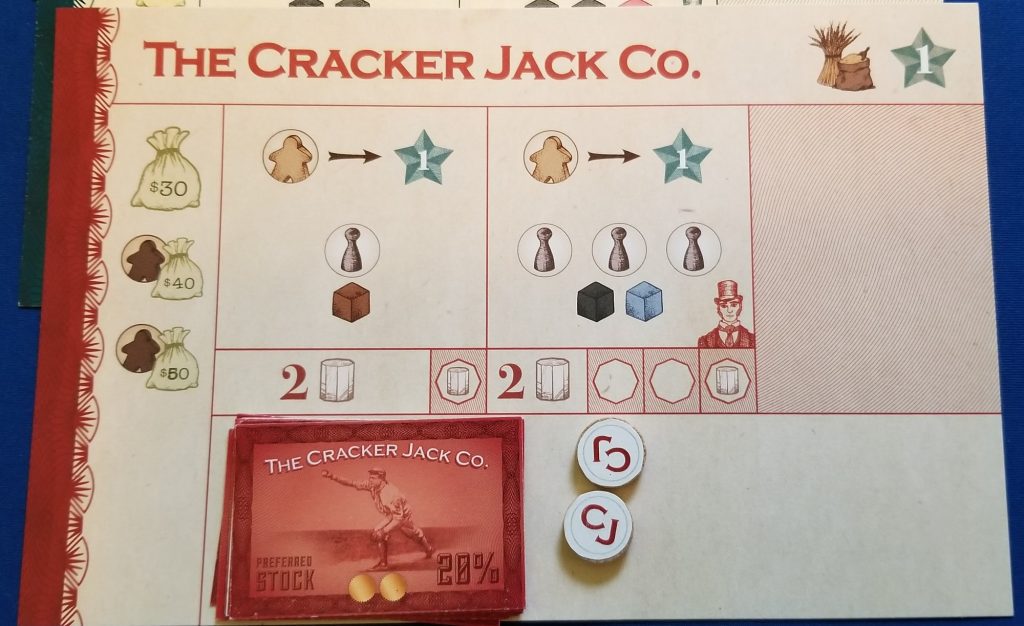
For example, if you selected a $50 Share Value, you would pay $150 (that’s $50 per 10% of the company) to start the company and company’s share value would be marked at $50 on the Share Value track. Now you own that company and will take its Company Charter. The octagonal Automation spots are filled in with Automation tokens from the general supply. Then mark the company’s appeal on the Appeal track according to the value on the Company Charter.
The position of a company’s Appeal marker on the Appeal track provides two benefits. First, as the Appeal marker moves you may unlock appeal bonuses (which provide you with some kind of benefit or extra money in your coffers). Secondly, this is how turn order is determined during the Operating Phase of the game.
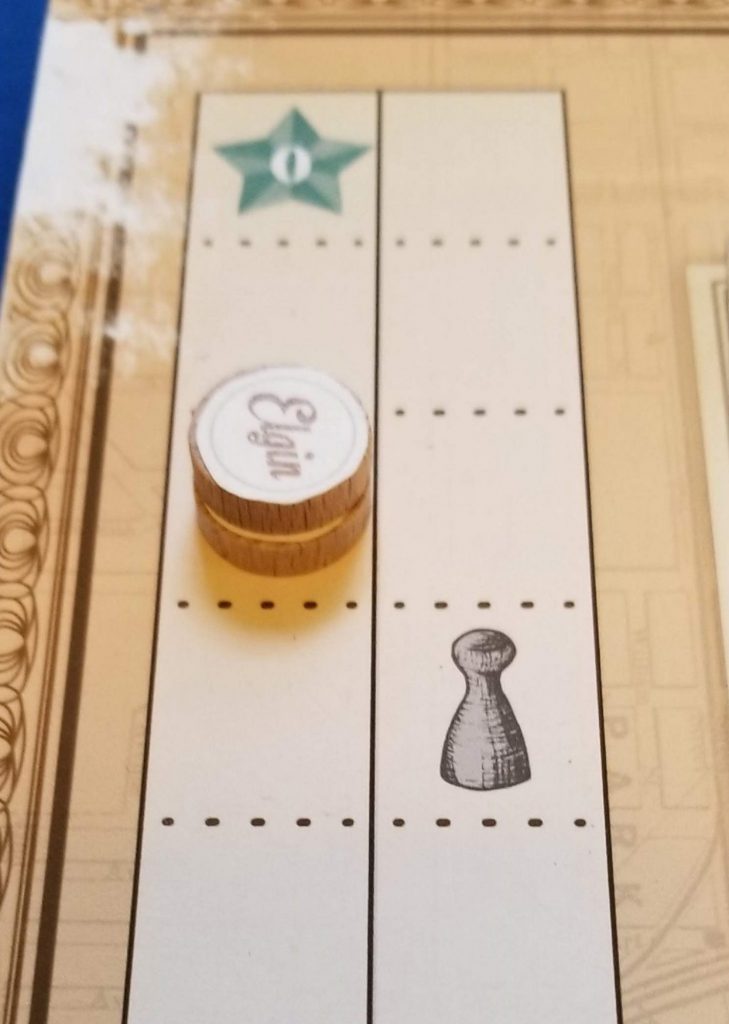
The last player to select a starting company receives the Priority Deal marker. Once the players have started their first companies, the person holding the Priority Deal marker places one of their Partners (this what the player color meeples are called in-game) onto the first spot on the Turn Order track. Then moving left from that player, everyone else places one of their Partners, in turn. This will be how turn order is handled for the remainder of the game.
Then the next phase begins.
The Stock Phase
In the Stock Phase, the players will be able to choose any or all of the following options in any order:
- Sell stock (as many as they want) to the bank earning money equal to the number of stocks sold times the current Share Value of the company. This causes the company’s Share Value to decrease. The sold share(s) are placed into the Bank Pool. The Director’s share may never be sold.
- After selling, you can then buy stock (one certificate) from the Bank Pool (if there are any there) or from any player-owned company (even your own). Money paid for stocks in the Bank Pool goes to the bank. Money paid for stocks in companies owned by the players goes directly into that company’s treasury. You cannot sell and buy stocks from the same company in the same round nor may you ever own more than 60% of any single company.
- Decline to perform a stock action.
The Stock Phase goes around and around, in turn order, until all players have passed in a row; you can pass and rejoin the phase later as long as everyone hasn’t passed. The person to the left of the last person to perform a stock action receives the Priority Deal marker.

The Building and Action Phases
During the Building Phase, each player selects a Building tile and plays it face down into the Building area of their color. They remove one Building tile in their hand from the game and keep the remaining one for future rounds. Then play proceeds into the Action phase.
In the Action phase, players take turns placing their Partners (worker placement style) on behalf of their companies. When a Partner performs an action for a company, all proceeds from that action are added to that company’s Charter. For instance, if a player chooses to use a Partner on behalf of A.G. Spalding and Bros. to pick up a Capital Asset tile (which provides a unique one-time benefit as well as a permanent benefit), that Capital Asset tile is then added to A.G. Spalding and Bros.’s Capital Asset field. Or if that Partner had been used to pick up a worker on behalf of Cracker Jack Co. that worker would be placed into a factory on Cracker Jack Co.’s Charter.

There are a lot of actions to choose from; some printed on the board and some provided by the Building tiles played by players throughout the game. Any costs associated with performing an action are paid from the treasury of the company the action is being performed on behalf of. This action selection continues until all players have placed all of their Partners. Then the Operating phase begins.
The Operating and Cleanup Phases
During the Operating phase, the companies operate in order from highest to lowest appeal. When operating, a company can purchase resources from the supply chain, produce goods, sell goods, pay dividends, and adjust its Share Value.
Purchasing resources: resources are purchased from the supply chain for the price printed on the space from which the resources are taken. In the following image, if you wanted to purchase all of the resource cubes from the $10 space, one from the $20 space, and two from the $30 space, you would pay $110 to the bank from your company’s treasury and then place those resources into that company’s treasury.

Producing goods: if a company has sufficient workers and resources it can produce goods. If worker spaces are filled with automation pieces, you may produce extra goods. If your factory has a manager, you may receive other bonuses.
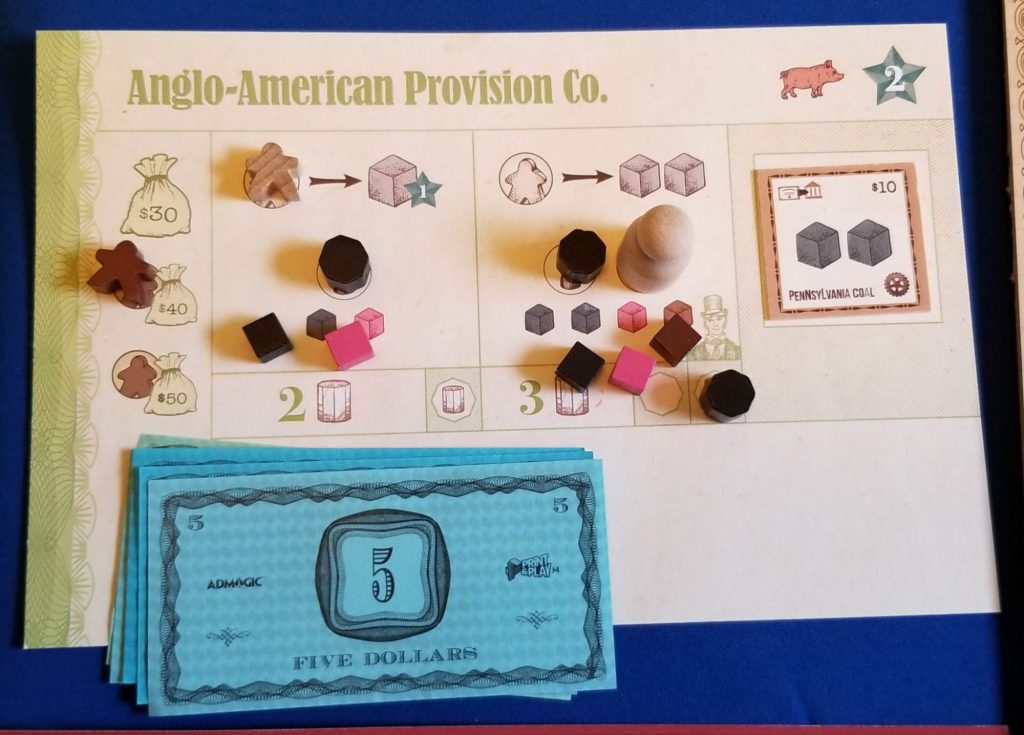
Selling goods: during setup, Demand tiles were placed onto the board. Each Demand tile requires a specific type of good. Each Company produces a specific good type, as printed on its charter. If you have goods of the appropriate type, you can place them onto the Demand tile (i.e. sell them). Each good sold this way earns your company money. Completing a Demand tile can also earn you a bonus!
Paying dividends: after successfully selling goods you may pay dividends, or withhold them. Determine the payout based on the earnings your company just made selling goods divided by ten. This is the amount, per share, each shareholder will earn. Paying out or withholding will cause the Share Value of your company to shift up or down depending upon the circumstances.
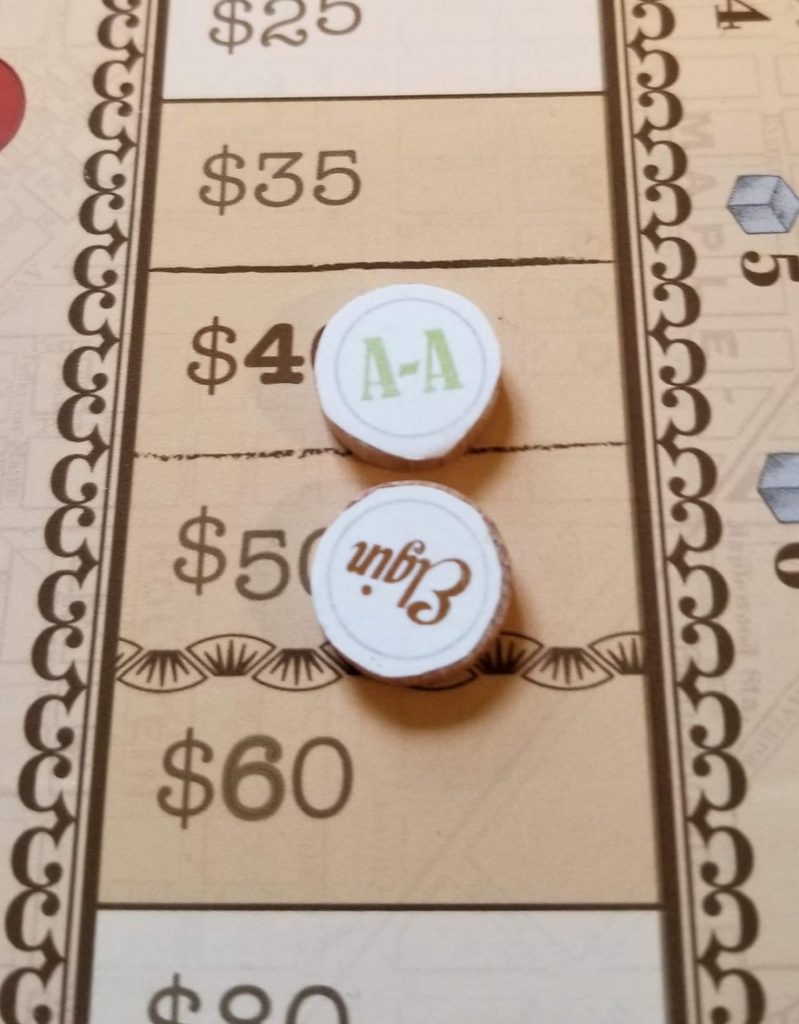
Once a company has finished its Operation Phase, the supply chain is refilled with resources drawn from the bag and the next company in line takes its turn, followed by the next, etc. After all companies have taken their turns, a Cleanup Phase is performed: return all players’ Partners, adjust the Phase and Round trackers, and shift and replenish Demand Tiles.
The Endgame
At the conclusion of the final round, each player cashes out all of their shares for their final share values and the player with the most money wins.
Thoughts
There is nothing small about City of the Big Shoulders. This is a very heavy game, both in literal and figurative terms. The prototype I received was shipped in a large yellow envelope. I moved all of the envelope contents over to my empty Terra Mystica Fire and Ice expansion box, and it barely stays closed. That’s how much content you’re getting in City of the Big Shoulders. And the largeness doesn’t end there.
Before I get to the game play, though, I want to take a moment to comment on the component quality. Bear in mind, this is just a prototype, but if it is in any way indicative of the final product, this will definitely be a game you’d be happy to have on your table. The cards are of good quality. The cardboard is nice and durable. The artwork is very well done. It has a very subdued vibe that is reminiscent of old-timey newspaper advertisements. Having seen other 18xx games, City of the Big Shoulders stands out because most games of this style feature very little artwork (if any at all). Emily R. Dearring has done an excellent job of bringing Raymond Chandler’s vision to life while also keeping everything clean and easy to digest.
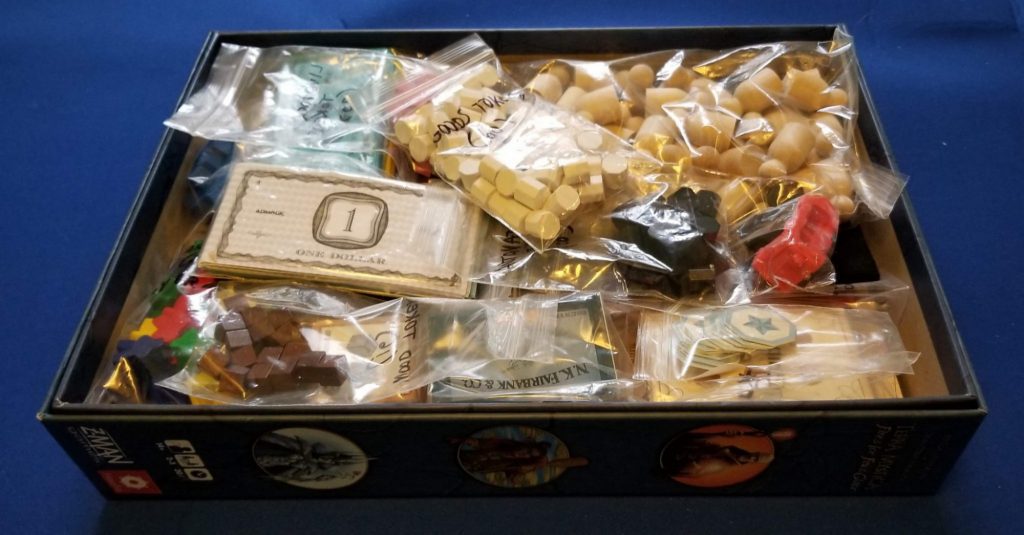
And, as I’ve hinted, there’s a lot to digest. City of the Big Shoulders looks scary to the untrained eye. There’s a lot going on and a lot of minutiae to remember. Photos of the game depict tokens, markers, and meeples seemingly scattered pell-mell across the board. It’s easy to feel overwhelmed before you’ve even begun playing. Once you get going, though, everything begins to click, and the game moves along smoothly.
City of the Big Shoulders gives you a lot to consider at any one time. At the top of this list is the question “How do I get the money from my company’s treasury into my own treasury?”. And, really, that’s the crux of the game. Money leftover in a company’s treasury at the end of the game is worth nothing, so you’re incentivized to pay out dividends as often as possible to keep your company’s treasury small. But you don’t want it to be too small. If you shortchange it too much, you won’t be able to produce goods and your Share Value will suffer as a result. And on top of this, you’re trying to balance your own personal budget. Ideally, you want to have a decent chunk of multiple companies in the game and that takes money. Do you risk all your capital on a stock that seems to be rising in the hopes that it keeps rising or do you try to be frugal and go for the low hanging fruit in the hopes that an unproven company’s stock will become more valuable? It’s always a gamble on whether or not you’re making the right decision.
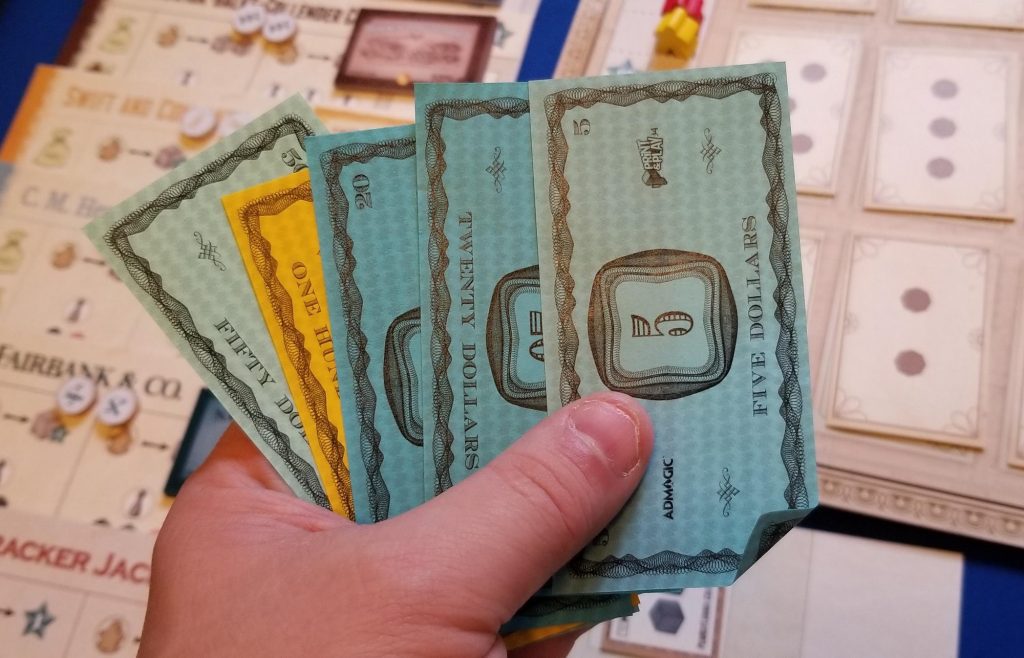
There are a lot of different strategies to pursue at any given time. The low hanging fruit strategy can be a viable one. So is colluding with your competitors to purposefully devalue someone else’s company’s stock. But can you trust your opponents to honor their commitments to devalue a stock or are they planning to buy up the stock (that you just forfeited) on the cheap? City of the Big Shoulders presents interesting opportunities and tactical avenues at almost every turn. And this just keeps me going back for more.
There’s almost nothing to dislike about this game, but there were a few minor issues that I ran into during my experiences with it. For starters, while the rule book is very detailed, there were several wording issues that gave us pause and caused a little bit of consternation as we debated the spirit of what the words actually meant. Secondly, the rule book that I was provided was more a rules document than an actual rule book. It repeatedly referred to illustrations or appendices that didn’t exist within the document. Several questions and issues arose during my plays that we just didn’t have an answer for… questions which I have no doubt the fully illustrated rule book or rules appendix would have answered. For instance, there was a Building tile that had some strange iconography on it. We took our best guess about what it meant and just went with that. After asking Raymond Chandler about it after the fact, I learned we’d played it very incorrectly.
Another concern we had was that some buildings felt way more powerful than others. In at least one game, one player wound up randomly drawing ALL of these powerful Building tiles. This tipped the game in his favor by netting him a very sizable income from people using his buildings consistently. That Player handily won the game as a direct result of it. We discussed this issue between ourselves at length afterward and all came to the consensus that drafting Building tiles rather than randomly dealing them out to people would be an effective method of preventing this particular issue.
And then there was the issue with the End Game. Recall how I mentioned several paragraphs ago that the money in a company’s treasury wasn’t worth anything? We felt that this really didn’t seem to make any sense thematically. In the real world, not only do you want to be wealthy, but you also want the company that you built from the ground up to be solvent as well. It seemed like you should be rewarded in some way if your masterful management of a company meant that it was making money hand over fist. That is just not the case, and it doesn’t sit very well with me. It is what it is, though. I’m sure there’s a good reason for it that I’m just not seeing.
Lastly, in the prototype that I received, there was no score pad included and this game definitely needs a score pad. Hopefully the Kickstarter campaign will address that. Hopefully.
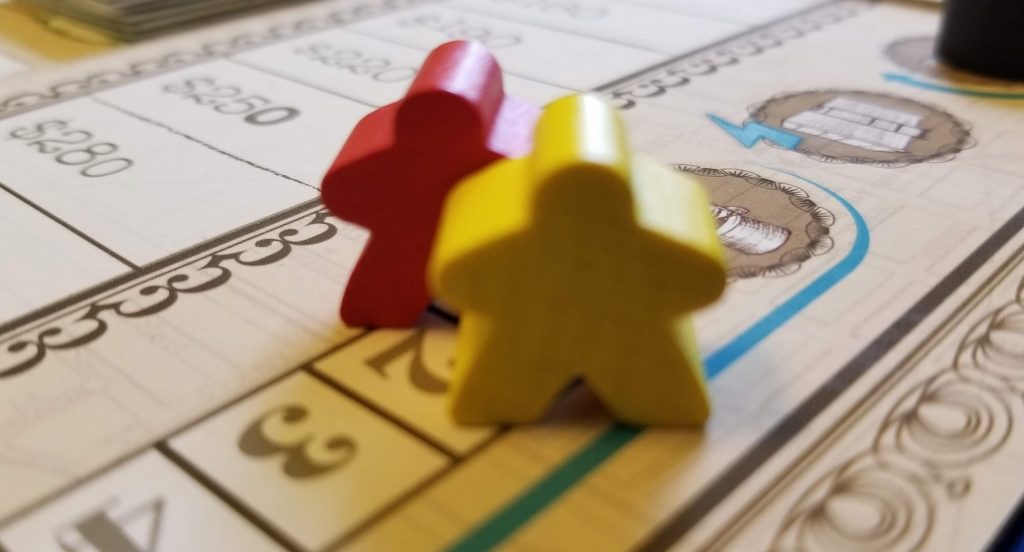
Aside from all of that, City of the Big Shoulders has blown me away. It is by far the most complex game that I have ever played. I always feel engaged at every turn, and not just with the game itself, but with the other players as well. Everything I do affects them directly and vice versa. In a way, even though we’re all competing, it’s like we’re all in it together. Thematically, that makes a lot of sense considering that we’re all working to rebuild a city from the ashes. I really like this game and I am definitely going to back this once it hits Kickstarter on November 6th.


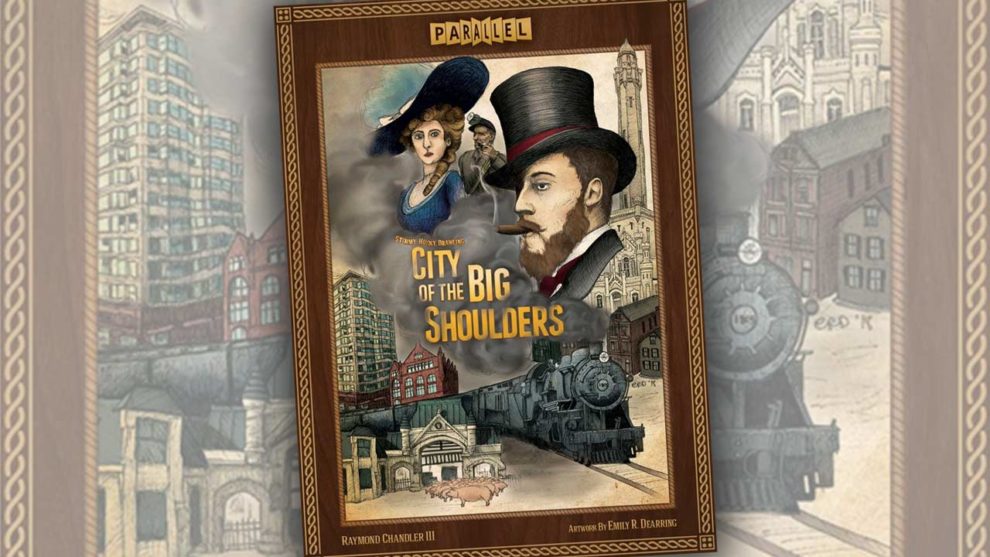

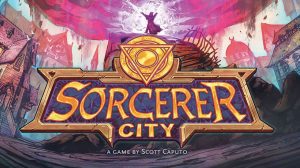






This one sounds really interesting! Nice write-up too 🙂
Hey. Thank you for the compliment and thank you for taking the time to read what I wrote. I’m pleased that you enjoyed it.
I also suspect that you’ll be pleased with this game if you happen to back it on Kickstarter. It is easily one of the best games that I have played all year.
Great write up. I’ve been following this since it was first mentioned by Heavy Cardboard. Can’t wait to try it. I posted this on BGG, but can you say how long game time is?
Necro-posting, but since the game has just been reprinted, I’ll call it justified. I adore this game, but it’s a heavy lift the first time around. Expect the teach to last 30-45 minutes, and the first game to take up 45-60 minutes per player. So your first 4p game could take over four hours.
BUT… once everyone gets it and the inevitable rules questions have been ironed out, it’s absolutely possible to play in 30-40 min per player. The game mechanics fall into place very nicely. The great thing is, with the right players, as soon as you finish game 1, they’ll be asking “when can we play this again?!”
Key to efficient plays:
– using chips is non-negotiable!
– trust everyone to get their own money from the bank
– have a calculator for dividends
– make a copy or two of the rule book pages re: Buildings and Capital Assets, so you don’t have to teach them all up-front… just look them up as they are revealed
– assign each person a task for cleanup phase: A does Capital Assets, B does the Demand tiles, C does the Resource markets